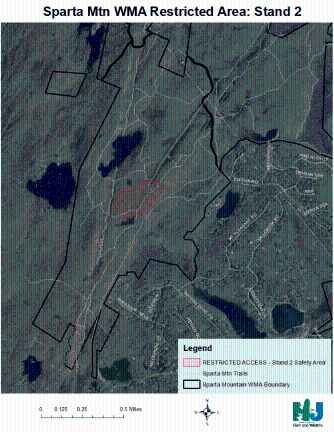Biologist: Logging aims to create young forest
SPARTA. Wildlife biologist says forest management is limited to a maximum of 10 acres a year.

Annual logging in the Sparta Mountain Wildlife Management Area (WMA) aims to create young forest areas and enhance oak forest, Sharon Petzinger, a wildlife biologist with the state Department of Environmental Protection (DEP), told the Township Council at its March 25 meeting.
“We’re cutting a lot of trees. It looks horrible, but it turns into something wonderful,” she said.
Because people are upset by the logging, the state amended its forest stewardship plan in 2021, limiting forest management to a maximum of 10 acres a year, said Petzinger, project manager of forestry activities in the Sparta Mountain WMA. She works with the DEP Fish and Wildlife’s Endangered and Nongame Species Program.
Treatments are limited to seed tree and shelterwood because they create young forest and help regenerate oak trees which enhances the biodiversity of wildlife, she said.
At least a third of the trees that are cut down are left there as they would have been if a disaster brought them down, she explained.
Three months later, the average number of bird species has increased from 10 to 16 and the number of rare and declining species has doubled from three to six. Three years later, the number of bird species has more than doubled and the number of rare and declining species has quadrupled.
History of the forest
The area New Jersey occupies was primarily an oak-hickory forest for the past 10,000 years, Petzinger said.
Strong hurricanes, which occurred every 85 to 150 years, and fires, which occurred every 20 years, kept the canopy open, she said. “Less than 7 percent of the forest of northern New Jersey was that old-growth eastern hemlock forest that you might imagine.”
Today, more than 90 percent of the Sparta Mountain WMA forest is mature, closed-canopy, she said. That’s because all the trees started growing back after Thomas Edison abandoned his mining operations there in 1930. “The past land use gives us a forest that is not entirely natural.”
Wildlife is intertwined with vegetation, she said. For example, a wood thrush will nest in a closed-canopy forest but its young chicks go to the young forest, which has more cover and more food. “The longer the distance the chicks have to move to find that young forest, the less likely they are to survive.”
From 1986 to 2015, more than 322,000 acres of young forest has been lost to development on private land, Petzinger noted. Another 44,000 acres of young forest has been lost on state land during that time as the forest has matured.
Purchased in 1994
The Sparta Mountain WMA was purchased by the state in 1994. That area and the nearby Edison bog and wetlands, owned by New Jersey Audubon, are managed cooperatively.
The northern part of the WMA, with 1,500 acres, was purchased in 2002 and 2007 with a grant from the U.S. Department of Agriculture’s Forest Service.
The WMA now has nearly 3,500 acres.
A forest stewardship plan was approved in 2009, then a new one in 2017. An addendum to the 2017 plan was adopted in 2021.
Dave Golden, assistant DEP commissioner overseeing Fish and Wildlife programs, said the DEP manages habitats for rare species, those listed as threatened and endangered and those “that are moving in a direction that gives us concern.”
”Certain species have narrow habitat requirements,” he said, citing as examples wetlands, grasslands, uplands, old-growth forests and very young forests.
“If we don’t have all of those habitat types in our landscape across New Jersey, then we won’t be able to do our jobs to make sure that we maintain species in New Jersey - the wide diversity that we currently have - for all the public and all future generations.”
Public comments
During public comments, Silvia Solaun, executive director of New Jersey Forest Watch and a Sparta resident, accused the DEP of “greenwashing” in using young forest as a reason for deforestation.
Sparta Mountain was purchased with Green Acres funds and “we New Jersey residents do not want to see our public forests continually degraded and destroyed under the guise of making them healthier.”
“Unfortunately, the intact species that need the forest to be a closed canopy - their needs are being ignored.”
Logging has hurt the vernal pools and created soil compaction and soil degradation, she noted.
While the DEP measures success by the number of bird species sighted, all the other effects are being ignored, Solaun said.
”We want to encourage a science-based methodology. It must be used and shared. If it’s not going to be shared, it’s not real data.”
Julia Somers, executive director of the New Jersey Highlands Coalition, said her group was told in 2018 that no logging would be done at the site “and, of course, now it is being logged.” “We don’t believe that we have been heard.”
In addition, the DEP’s treatment being used in the Sparta Mountain WMA is the same one that a hunting group recommends for creating deer habitat, Somers said. “And we have a terrible problem with the over-presence of deer on Sparta Mountain.”
Richard Kelsky, vice president of the New Jersey Forestry Association, said the Highlands Council reported that anticipated tree regeneration is occurring on multiple sites and found no observed activities of concern related to Highlands resources. “Typically, the Highlands Council is very critical of these types of projects. That’s not reflected in either of these two documents.”
In answer to a question, Petzinger said her salary is paid by a state wildlife grant and the logging is funded by the state’s corporate business tax.
The logging contractor controls what happens to the logged trees, she said.
The longer the distance the chicks have to move to find that young forest, the less likely they are to survive.”
- Sharon Petzinger, wildlife biologist, state Department of Environmental Protection